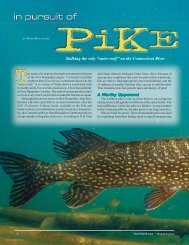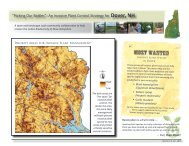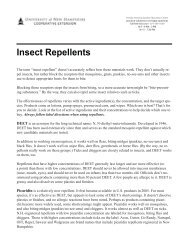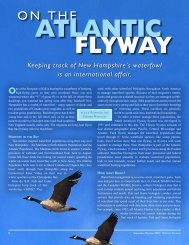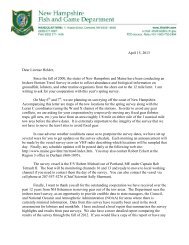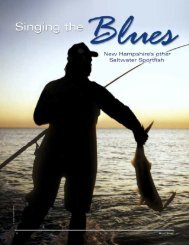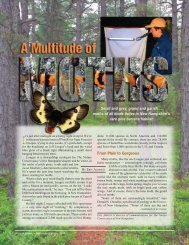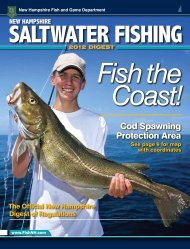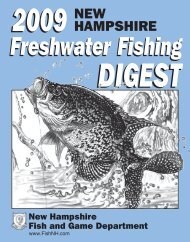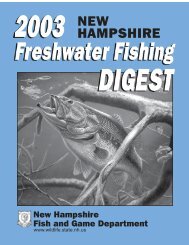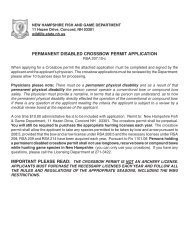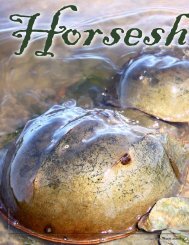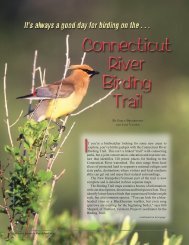Mad for Molluscs - New Hampshire Fish and Game Department
Mad for Molluscs - New Hampshire Fish and Game Department
Mad for Molluscs - New Hampshire Fish and Game Department
Create successful ePaper yourself
Turn your PDF publications into a flip-book with our unique Google optimized e-Paper software.
What do shellfish tell us about our environment...<br />
<strong>and</strong> how can I get some <strong>for</strong> supper?<br />
hellfish – mussels, clams, oysters <strong>and</strong> others – aren’t just<br />
good <strong>for</strong> chowder or bait. As filter feeders <strong>and</strong> as food <strong>for</strong><br />
other creatures, shellfish are critical components of marine<br />
ecosystems that contribute to healthy waters, <strong>and</strong> they can<br />
help indicate when waters aren’t healthy.<br />
Shellfish filter tremendous amounts of water each day, <strong>and</strong><br />
in doing so, help keep water clear <strong>and</strong> clean. The<br />
health of shellfish is directly related to the water<br />
quality of the local environment — because they<br />
filter great amounts of water, shellfish absorb contaminants<br />
from the water that accumulate in their<br />
flesh. This means if a clam is living in dirty water that has high<br />
levels of bacteria, that clam will also contain high levels of<br />
bacteria <strong>and</strong> be unsafe to eat. It’s a simple equation: Healthy<br />
shellfish equal clean water.<br />
Because of the close relationship between shellfish <strong>and</strong><br />
water quality, the <strong>New</strong> <strong>Hampshire</strong> <strong>Department</strong> of Environmental<br />
Services Shellfish Program, the <strong>New</strong> <strong>Hampshire</strong> Estuaries<br />
Project <strong>and</strong> other partners are working to monitor shellfish in<br />
<strong>New</strong> <strong>Hampshire</strong> <strong>and</strong> make their restoration <strong>and</strong> maintenance a<br />
priority, as well as to open more harvesting areas <strong>and</strong> support<br />
education about these ecologically important species.<br />
Declining Clams <strong>and</strong> Oysters<br />
Although many kinds of shellfish are available <strong>for</strong> harvest,<br />
the populations of some species have fallen on hard times in<br />
recent years. Researchers estimated a harvestable softshell<br />
clam population in Hampton/Seabrook harbor of 25,000 bushels<br />
in 1997, but that number had fallen to 3,276 bushels in 2003,<br />
<strong>and</strong> has not recovered since. Scientists believe there are multiple<br />
reasons <strong>for</strong> the decline. Some feel the ups <strong>and</strong> downs are<br />
typical of a common predator-prey relationship: when clams<br />
are plentiful, there is greater harvesting pressure, <strong>and</strong> populations<br />
decline. Once it becomes hard to find clams, harvest<br />
pressure eases, <strong>and</strong> the clams eventually rebound. Other factors,<br />
such as disease <strong>and</strong> predation by green crabs, also appear<br />
to play a role.<br />
Oyster populations have also significantly declined in recent<br />
years. Biologists estimated over 128,000 bushels of harvestable<br />
oysters in <strong>New</strong> <strong>Hampshire</strong> in 1993. Today, the annual harvest<br />
is about 6,700 bushels. Most researchers believe the major<br />
cause of this decline was the impact of two oyster diseases,<br />
MSX <strong>and</strong> Dermo. These diseases weaken oysters <strong>and</strong> either kill<br />
BY CHRIS NASH<br />
them outright or make them more susceptible to other hazards.<br />
Oyster fisheries in the Chesapeake Bay <strong>and</strong> other mid-Atlantic<br />
estuaries also have been severely damaged by these two diseases<br />
<strong>and</strong> have not recovered.<br />
Is there any good news? Yes, there appear to be a good<br />
number of juvenile oysters in several <strong>New</strong> <strong>Hampshire</strong> beds as<br />
a result of a successful breeding season in 2002, <strong>and</strong><br />
these oysters currently are at or close to harvestable<br />
size. Also, several oyster restoration projects sponsored<br />
by the N.H. Estuaries Project, the University<br />
of <strong>New</strong> <strong>Hampshire</strong> Jackson Estuarine Laboratory<br />
<strong>and</strong> other organizations are beginning to produce positive<br />
results.<br />
On the Flats<br />
Although clam <strong>and</strong> oyster populations themselves may be in<br />
decline, the number of areas open to harvest continues to<br />
increase, giving harvesters more areas to seek their limit. Since<br />
2000, over 600 acres of estuarine waters have been reopened to<br />
harvesting.<br />
Shellfish are<br />
an important food<br />
source to many<br />
other marine species<br />
– <strong>and</strong> to<br />
humans too. Seafood<br />
lovers know<br />
that “fresh is<br />
best,” <strong>and</strong> hundreds<br />
of <strong>New</strong><br />
<strong>Hampshire</strong> residents<br />
know the<br />
secret to getting<br />
the freshest shellfish<br />
around – dig Estuarine mudflats provide habitat <strong>for</strong><br />
’em yourself! A softshell clams. Clams can also be found<br />
modest amount of in the muddy shorelines adjacent to tidal<br />
shellfish harvesting,<br />
done with that the area they intend to dig is open<br />
creeks. Harvesters should always verify<br />
care using traditional<br />
tools, does<br />
<strong>for</strong> harvesting.<br />
not have a significant impact on overall populations.<br />
continued on next page<br />
WILDLIFE JOURNAL • July/August 2006 9<br />
CHRIS NASH PHOTO



